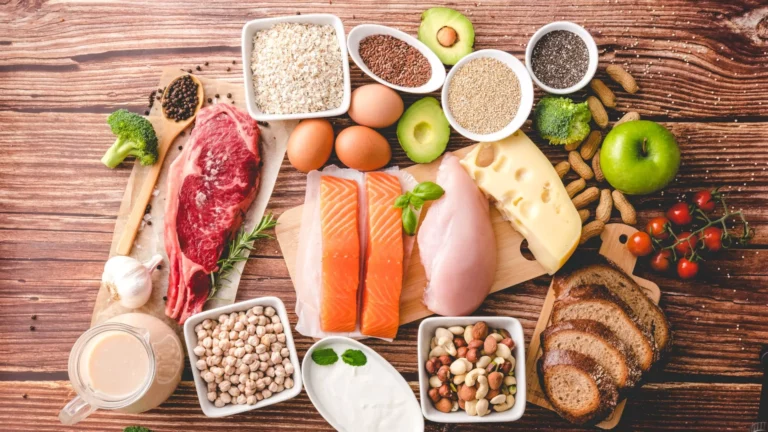Table of Contents
Most people don’t struggle with eating well. They struggle with deciding what to eat. By the time you’ve scrolled through delivery apps or stared into your fridge, your energy is gone, your hunger’s loud, and your wallet’s about to take a hit.
That’s where a 30-minute meal planning system makes all the difference. It’s not about becoming a chef or meal-prep perfectionist. It’s about creating a rhythm that keeps you fed, calm, and financially grounded even when life feels chaotic.
With the right structure, you can plan, shop, and prep for an entire week in less time than it takes to watch an episode of your favorite show. Here’s how to make it happen:
The Real Cost of Not Planning Meals
When you wing your meals, the cost isn’t just financial. It’s mental and physical, too.
- Food waste piles up. The average household throws out 20% of what they buy because it spoils before use. That’s $1,500 a year gone.
- Impulse spending spikes. Grabbing takeout “just this once” can easily add up to $40–$60 a week in extras.
- Decision fatigue sets in. Every day starts with “What should I eat?” and ends with “Never mind, I’ll just order.”
A little forethought saves hours, dollars, and sanity. But traditional meal prep can feel unrealistic. That’s why this system trims it to what actually works for busy people.
Read related blog: Frugal Meal Planning Tips for Single-Person Households
The 30-Minute Meal Planning System
Think of this as your weekly financial and food reset. A simple ritual that runs itself once you set it up.
Step 1: Set Your Meal Rhythm (5 Minutes)
Start by mapping your week’s energy levels and schedule. Don’t plan the same intensity for a Wednesday night as you would for a Sunday afternoon.
- 3 categories: Quick-cook meals, leftovers, and flexible nights (for takeout or events).
- Anchor points: Pick 2 “big prep” days—often Sunday and Wednesday—for batch items like cooked grains, roasted veggies, or proteins.
- Smart rotation: Repeat meal types (Taco Tuesday, Pasta Friday). Predictability saves mental energy.
In five minutes, your week already has structure and fewer dinner debates.
Step 2: Choose 5 Base Meals (10 Minutes)
You don’t need 21 unique dishes; you need five versatile base meals that adapt.
Here’s the formula that keeps it simple and balanced:
- One grain-based bowl: (rice, quinoa, or couscous with veggies and protein)
- One one-pan sheet dinner: (protein + seasonal vegetables roasted together)
- One fast pasta or noodle dish: (olive oil, garlic, and whatever greens you’ve got)
- One soup or stew: (stretchable, freezable, reheatable)
- One wildcard meal: (wraps, stir-fry, tacos—something fun)
Write them down, rotate them weekly, and your meal base will never feel repetitive.
Step 3: Shop Like a Strategist (10 Minutes)
Forget long grocery lists. Think templates.
- Pantry staples Include Rice, pasta, canned beans, sauces, oils, and spices. Refill monthly, not weekly.
- Fresh items: Buy perishable produce in batches of 3–4 days to minimize waste.
- Protein balance: Mix cost-effective proteins (like lentils, eggs, or tofu) with one or two premium ones (fish or lean meat).
- Smart swaps: Buy frozen vegetables—they’re cheaper, last longer, and retain nutrients.
Pro tip: Order groceries online while reviewing your meal plan to save time and effort. It locks in discipline and saves impulse spending in-store.
Step 4: 15-Minute Sunday Prep (Optional but Powerful)
Meal prep doesn’t mean endless chopping. It means pre-positioning.
- Cook a base grain or pasta.
- Roast or sauté a batch of vegetables.
- Portion proteins into ready-to-cook containers.
- Prep one sauce or dressing to tie meals together.
That’s it. Those few actions give you a head start every day. Most meals will now take under 15 minutes to prepare and serve.
Step 5: Track Your Savings (and Wins)
The beauty of this system isn’t just smoother evenings. It’s the money you’ll visibly save.
- Cut your grocery waste by 20–30%.
- Slash the takeout frequency by half.
- Reuse ingredients creatively (chickpeas in salad → soup → wraps).
Quick Real-Life Example: The 30-Minute Sunday Reset
Time spent: 25 minutes.
Tools: Timer, list, containers
- Open your fridge, toss what’s expired, and list what’s left. (3 min)
- Choose five meal types for the week and assign them to days. (5 min)
- Build a short grocery list from what’s missing. (7 min)
- Roast a tray of vegetables + cook one batch of grain. (10 min)
Done. You just saved yourself five takeout nights, an hour of daily indecision, and probably $60–$100 in the week ahead.
The “Emergency Drawer” Strategy: Your Safety Net for Off-Days
Even the best planners have nights when things fall apart: meetings run late, energy tanks, or you don’t feel like cooking. That’s where your “Emergency Drawer” saves the day.
What it is: a shelf, box, or digital list of instant meal backups that don’t derail your budget or diet.
What it includes:
- Canned soups, lentils, or beans (protein + fiber + 5-minute prep)
- Frozen dumplings or veggie patties for zero-effort dinners
- Shelf-stable grains like couscous, quinoa cups, or rice pouches
- Jarred sauces (pesto, curry paste) for quick flavor boosts
- Snackable fillers — nuts, oats, or protein bars for busy mornings
Think of this as your “grace plan.” You’ll still eat well without resorting to takeout, and it prevents one bad day from snowballing into a wasteful week.
Batch Cooking Without the Burnout
Traditional batch cooking sounds efficient until you’re drowning in six containers of the same chili. Instead, try micro-batching: cook versatile ingredients, not full meals.
How it works:
- Roast one tray of vegetables, not the entire recipe.
- Cook grains plain, then flavor later (garlic butter one day, soy sauce the next).
- Grill or bake proteins with minimal seasoning so they adapt to multiple cuisines.
- Freeze half your batch right away. Future-you will thank you.
This modular approach keeps meals dynamic, prevents “leftover fatigue,” and cuts your cooking time during the week to nearly zero.
Read related blog: Beem Health for Busy Parents: Managing Kids’ Health on a Budget
The Psychology of Meal Planning
Most people think meal planning is restrictive. In reality, it’s liberating. You’re not forcing structure. You’re removing uncertainty.
By pre-deciding what’s for dinner, you free up mental energy for everything else. You eat better without willpower, and spend smarter without spreadsheets. Over time, this habit becomes the backbone of your health and budget.
What to Do When You Get Bored With Your Meal Plan
Boredom is the #1 meal planning killer. But it’s preventable.
- Rotate themes, not meals. Keep a few constants but swap cuisines (Mediterranean, Mexican, Asian).
- Batch-based, vary toppings. Same quinoa bowl, different sauces or proteins.
- Use “flavor upgrades.” A jar of salsa, hot sauce, or tahini changes everything.
- Build a “Go-To” rotation list. Keep a running note of 10 fast favorites. When ideas run low, pull from it.
Predictable doesn’t mean boring. It means sustainable.
The Flavor Matrix: How to Build Infinite Variety from Minimal Ingredients
Meal planning fails when food feels repetitive. But variety doesn’t need complexity. It just needs a system. Enter the Flavor Matrix.
Start with five categories: Base (grain/protein), Texture (crunchy/creamy), Sauce, Accent (herbs/spices), and Fresh element.
Mix and match across cuisines:
- Mexican: Rice + black beans + salsa + cilantro + avocado
- Asian: Noodles + tofu + soy-ginger glaze + scallions + sesame
- Mediterranean: Couscous + chickpeas + olive oil + parsley + lemon
- Indian: Lentils + basmati + curry paste + coriander + yogurt
From these combinations, you can generate dozens of dishes without ever buying exotic ingredients or following rigid recipes.
This method makes meal planning feel creative, not confined, like jazz instead of sheet music.
The Math Behind the Meal Plan: Weekly ROI
| Category | Typical Weekly Spend | With Meal Planning | Savings |
| Groceries | $150 | $100 | $50 |
| Takeout | $60 | $20 | $40 |
| Food Waste | $20 | $5 | $15 |
| Total Savings | — | — | $100+/week |
That’s over $5,000 a year, reclaimed just by spending 30 minutes once a week.
The Emotional ROI: Calm, Control, and Confidence
It’s not just about saving money.
- You walk into your kitchen already knowing what’s next.
- You stop guilt-buying takeout because your food is waiting.
- You spend more evenings eating, not planning.
Meal planning gives you back mental bandwidth, and that’s worth more than any recipe.
The Financial Layer: How Meal Planning Connects to Your Bigger Money Goals
Every home-cooked meal isn’t just nourishment. It’s an investment return. You’re earning back what others lose to convenience.
Let’s do the math:
- 3 takeouts avoided per week = $90 saved
- 1 fewer grocery trip per month = $25 saved
- Less spoilage = $10 saved weekly
That’s $5,000+ annually. Money that could fund an emergency cushion, investment contributions, or a vacation.
How Beem Makes Meal Planning Effortless
Beem connects financial awareness with real-life habits.
- Everdraft™ Instant Cash: Helps cover grocery runs before payday, interest-free.
- Beem’s Budget Planner: This feature helps you budget and lets you see your efficiency improve week after week.
The Social Side of Meal Planning: Shared Systems, Shared Wins
Meal planning doesn’t have to be a solo sport. Sharing it makes it stick and makes it fun.
Try this:
- Family syncs: Each member chooses one meal for the week. Rotating control keeps everyone invested and reduces planning fatigue.
- Roommate co-ops: Split ingredient costs and prep sessions. Cooking together cuts waste and strengthens bonds.
- Digital meal swaps: Create a group chat or shared folder with 5-ingredient recipes your friends love. It’s a mini community cookbook that grows organically.
When meal planning becomes a collaborative effort, it shifts from a chore to a connection. Food turns into conversation, not just consumption.
FAQs on Meal Planning for Busy Weeks: The 30-Minute System
How much time should I spend on meal planning each week?
About 30 minutes is enough. 10 for planning, 10 for shopping, and 10 for prepping. Once you repeat it for 2–3 weeks, it becomes second nature and even faster.
What if I hate cooking?
Then keep it ultra-simple. Use semi-prepped ingredients like pre-cut veggies or rotisserie chicken. Meal planning isn’t about gourmet; it’s about removing the daily scramble.
Can this system work for families or roommates?
Absolutely. In fact, it saves more when shared. Rotate planning duties, agree on a meal rhythm, and split grocery costs tracked via Beem for fairness and transparency.
How do I handle unexpected dinners out?
Plan for one or two “flex nights” every week. That way, spontaneous plans don’t wreck your system. They’re already built in.
Does meal planning really save money in the long term?
Yes. Consistency compounds. Cutting even two takeouts a week can save over $ 2,000 annually. Plus, you waste less food, which is a silent budget drain most people overlook.
From Chaos to Clarity: A 30-Minute Investment That Multiplies
Meal planning isn’t just about food. It’s about flow. You’re turning a daily stressor into a weekly strategy that frees up time, money, and headspace.
With the Beem’s Budget Planner tracking your grocery spending, optimizing your budget, and rewarding your savings, your kitchen becomes part of your financial ecosystem—predictable, calm, and quietly profitable. Download the app now!
One half-hour a week. One list. One habit that pays off every single day.















































